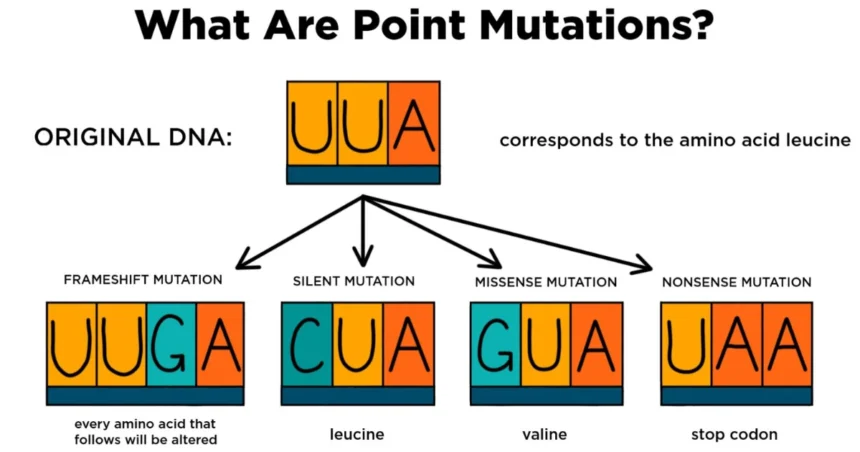Hey there! If you’ve ever wondered how tiny changes in our DNA can make a big difference, you’re in the right place. Today, we’re diving into the world of genetic mutations, specifically focusing on frameshift mutations and how they compare to other types like substitution, nonsense, silent, and deletion mutations. Don’t worry if these terms sound like science jargon—I’ll break them down in a way that’s easy to understand, whether you’re a curious teen, a parent, or just someone interested in how our genes work. Let’s get started!
What Are Genetic Mutations?
Imagine your DNA as a super long recipe book that tells your body how to make proteins, the building blocks of life. This recipe is written in a code made up of four letters: A, T, C, and G. These letters form “which is a frameshift mutation? substitution nonsense silent deletion” (called codons) that your body reads to build proteins. A mutation is like a typo in this recipe—it changes the instructions, and sometimes, that can lead to big changes in how your body works.
Mutations can happen for all sorts of reasons, like exposure to radiation, chemicals, or even just random errors when your cells copy DNA. Some mutations don’t cause any problems, while others can lead to health issues. Today, we’re focusing on four specific types of mutations: frameshift, substitution, nonsense, and silent, with a special look at how deletion fits in.
What Is a Frameshift Mutation?
Let’s start with the star of the show: the frameshift mutation. To understand it, think of your DNA as a sentence: “THE CAT ATE THE RAT.” Each group of three letters (a codon) is like a word that your body understands. Now, if you accidentally add or remove a letter, the whole sentence shifts, and the words don’t make sense anymore.
For example, if you delete the letter “T” from “THE,” the sentence becomes: “HEC ATA TET HER AT.” Suddenly, the words are jumbled, and the meaning is lost. That’s exactly what happens in a frameshift mutation. It occurs when one or more DNA bases (letters) are added (insertion) or removed (deletion), and this shifts the “reading frame” of the DNA code. Since the code is read in groups of three, this shift messes up every codon that follows, often creating a completely different protein—or no protein at all.
Frameshift mutations are usually serious because they can drastically change the protein’s structure, making it unusable. This can lead to diseases like cystic fibrosis or Tay-Sachs disease, where the body can’t function properly due to faulty proteins.
Comparing Frameshift to Other Mutations
To really get what makes a frameshift mutation unique, let’s look at the other types of mutations you mentioned: substitution, nonsense, silent, and deletion. Each one affects the DNA recipe in its own way.
Substitution Mutation
A substitution mutation is like swapping one letter for another in our DNA sentence. For example, changing “THE CAT ATE” to “TBE CAT ATE.” Here, just one letter (base) in the DNA is replaced with another. Depending on the change, it might have a small effect or a big one.
There are three types of substitution mutations:
-
Silent: The change doesn’t affect the protein because the new codon still codes for the same amino acid. It’s like a typo that doesn’t change the recipe’s outcome.
-
Missense: The change results in a different amino acid, which might alter the protein’s function slightly or significantly. Think of it as using sugar instead of salt in a recipe—it might still work, but it’ll taste different.
-
Nonsense: The change turns a codon into a “stop” signal, cutting the protein short. This is like stopping the recipe halfway through, leaving you with an incomplete dish.
Nonsense Mutation
A nonsense mutation is a specific type of substitution mutation. It’s when a single base change turns a codon that codes for an amino acid into a “stop” codon. Imagine our sentence “THE CAT ATE THE RAT” becoming “THE STOP ATE THE RAT.” Everything after “STOP” gets ignored, so the protein is cut short and often doesn’t work. This can cause serious conditions like Duchenne muscular dystrophy.
Silent Mutation
A silent mutation is another type of substitution, but it’s the least disruptive. It’s like changing “colour” to “color” in a recipe—same meaning, no big deal. In DNA, the codon still codes for the same amino acid, so the protein stays the same. These mutations usually don’t cause any problems, but they can sometimes affect how DNA is processed in subtle ways.
Deletion Mutation
A deletion mutation is when one or more DNA bases are removed. If the number of bases deleted isn’t a multiple of three, it causes a frameshift mutation because it shifts the reading frame. For example, deleting one base in “THE CAT ATE” to make “HE CAT ATE” shifts everything, creating gibberish. But if three bases (a whole codon) are deleted, like “THE ATE THE RAT,” it might remove one part of the protein but not shift the frame, so it’s not always a frameshift mutation.
How Do These Mutations Differ?
To make things crystal clear, let’s break down the differences in a simple table:
|
Mutation Type |
What Happens? |
Effect on Protein |
Example in DNA |
Impact |
|---|---|---|---|---|
|
Frameshift |
Insertion or deletion of bases (not a multiple of 3), shifting the reading frame. |
Completely changes the protein sequence after the mutation, often making it nonfunctional. |
TAC GGA → TAAC GGA (insertion of A) |
Usually severe, e.g., cystic fibrosis. |
|
Substitution |
One base is swapped for another. |
Depends on the type: silent (no change), missense (different amino acid), or nonsense (early stop). |
TAC → TGC |
Varies from no effect to severe. |
|
Nonsense |
A substitution that creates a stop codon. |
Protein is cut short, often nonfunctional. |
TAC → TAG (stop codon) |
Often severe, e.g., muscular dystrophy. |
|
Silent |
A substitution that doesn’t change the amino acid. |
No change in protein function. |
TAC → TAT (both code for tyrosine) |
Usually harmless. |
|
Deletion |
Removal of one or more bases. |
If not a multiple of 3, causes a frameshift; if a multiple of 3, removes part of the protein. |
TAC GGA → TA (deletion of C GGA) |
Varies; frameshift deletions are severe. |
Why Do Frameshift Mutations Matter?
Frameshift mutations stand out because they’re often the most disruptive. Since they mess up the entire reading frame, they can turn a perfectly good protein into something that doesn’t work at all. Think of it like a book where every word after page 10 is scrambled—reading it would be impossible! This is why frameshift mutations are linked to serious genetic disorders.
For example, in cystic fibrosis, a deletion of three bases in the CFTR gene doesn’t cause a frameshift (since it’s a multiple of three), but other frameshift mutations in the same gene can lead to severe symptoms like lung infections and digestive problems. Similarly, Tay-Sachs disease can result from frameshift mutations that stop the production of a key enzyme, leading to neurological issues.
How Do These Mutations Happen?
Mutations can happen naturally or due to external factors. Here’s a quick rundown:
-
Random errors: When your cells copy DNA, mistakes can slip in, like a typo in a text message.
-
Environmental factors: Things like UV radiation, cigarette smoke, or certain chemicals can damage DNA.
-
Inherited mutations: Some mutations are passed down from parents, which is why genetic testing can help identify risks.
Frameshift mutations, in particular, often happen when DNA replication goes wrong, and extra bases are added or skipped. It’s like accidentally hitting “copy-paste” or “delete” on your keyboard while typing out a sentence.
Can Mutations Be Fixed?
The good news? Scientists are working hard to fix or manage the effects of mutations. Here are a few exciting developments:
-
Gene therapy: This involves replacing faulty genes with healthy ones. It’s like editing the typo out of the recipe.
-
CRISPR: This is a tool that lets scientists cut and paste DNA with incredible precision, potentially fixing frameshift mutations.
-
Medications: For some conditions, drugs can help manage symptoms caused by mutations, even if they don’t fix the DNA itself.
For example, in cystic fibrosis, new drugs like Trikafta help the faulty protein work better, improving quality of life for many patients.
How to Spot Frameshift Mutations
If you’re curious about identifying mutations, genetic testing is the way to go. Scientists use tools like DNA sequencing to read the exact order of bases in your DNA. If they spot an insertion or deletion that shifts the reading frame, they’ll know it’s a frameshift mutation. This is especially important for diagnosing genetic disorders or understanding your risk for certain diseases.
Why Should You Care?
You might be thinking, “This is cool, but why does it matter to me?” Well, understanding mutations helps us appreciate how our bodies work and why some people face certain health challenges. It also sheds light on why genetic research is so important—it’s not just about science; it’s about improving lives. Whether it’s developing new treatments or helping families understand their genetic risks, this knowledge makes a real difference.
Plus, mutations aren’t always bad! Some can give us unique traits, like resistance to certain diseases. For example, a mutation in the CCR5 gene can make some people resistant to HIV. Pretty cool, right?
Wrapping It Up
So, which is a frameshift mutation? It’s a type of mutation where bases are added or removed in a way that shifts the DNA’s reading frame, scrambling the protein instructions. Unlike substitution (which swaps one base), nonsense (which stops the protein early), or silent (which doesn’t change the protein), frameshift mutations are often the most severe because they disrupt everything downstream. Deletion mutations can cause frameshifts if they remove bases in a way that misaligns the code.





